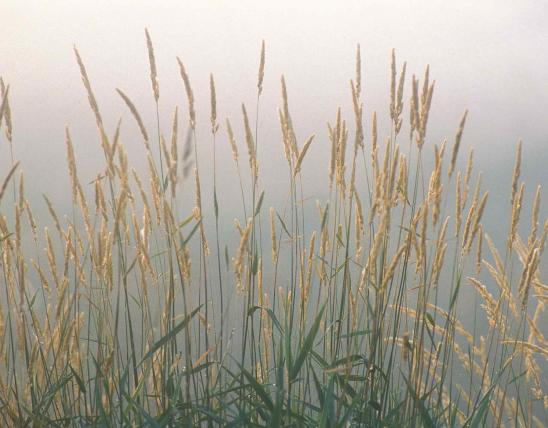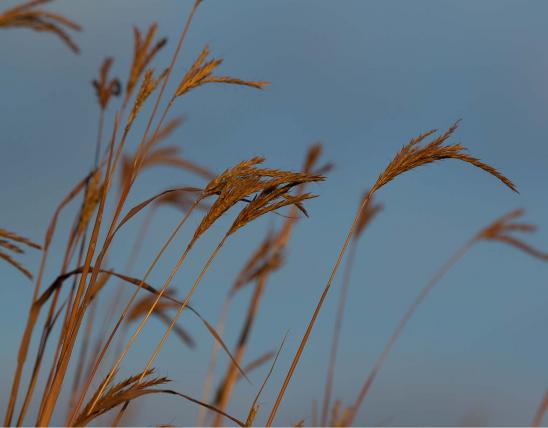
Orchard grass is an introduced perennial, clump-forming, cool-season grass, without rhizomes. Its flower stalks have relatively few branches, and the flowers are grouped into dense clusters of spikelets that are usually oriented mostly to one side their branch stalk.
The flowering stems may be up to nearly 4 feet tall and are somewhat flattened, especially near the base. The leaf sheaths are closed to about the midpoint and are keeled (V-shaped in cross-section). At the junction of the leaf sheath and leaf blade is a well-developed ligule (membranous flap) to about ½ inch long; it is sometimes hairy and is usually torn into several lobes at maturity. Leaf blades are 3–16 inches long. Orchard grass is usually a bluish or grayish green.
Flower clusters are in panicles 2¾–8 inches long. There are relatively few branches, and these are either ascending or spreading. Dense headlike clusters of spikelets are at the ends of the otherwise naked branches; the spikelets are oriented more or less to one side of the branch stalk. Flowers May–August.
Height: flowering stems 14–47 inches.
Common to scattered nearly statewide.
Habitat and Conservation
Occurs in disturbed portions of bottomland forests and mesic (moist) upland forests, upland prairies, and margins of ponds. Also occurs on pastures, old fields, levees, roadsides, fencerows, and disturbed areas.
Native to Europe, orchard grass has been widely naturalized in North America and elsewhere in the world. In the past, orchard grass was more commonly planted as a pasture grass for hay and forage. It was naturalized in eastern Missouri by 1860.
Status
Introduced perennial, clump-forming, cool-season grass.
Orchard grass is the only species in its genus, though botanists have debated whether to include a few other plants with it. In Eurasia, botanists have recorded several subspecies, but in America these are generally not distinguishable.
Human Connections
Orchard grass pollen is one of the principal causes of hay fever in May and June.
People have introduced orchard grass to many parts of the world. In some places, it is considered invasive.
Orchard grass has a long history for use as a forage or pasture plant, which helps to account for its being introduced so many places. As the season wears on, orchard grass’s foliage gets tougher and less palatable to grazing animals.
Orchard grass, often with a mix of oats, wheat, barley, and/or rye, is often sold as so-called cat grass. Owners of indoor cats sow the seeds in pots and make the tender grass blades available to their cats, which chew the leaves as a nutritional supplement. This may also draw the cat’s attention away from chewing houseplants.
Ecosystem Connections
A variety of insects either chew the leaves, bore into the stems or roots, or suck the sap of orchard grass. Grasshoppers, beetles, leaf-mining fly larvae, aphids, and others are fed by this species. Some of the Missouri’s butterflies and moths that use it as a caterpillar food plant are the little wood satyr and the unarmed and many-lined wainscot moths. Since orchard grass is native to Eurasia, there are many additional insects on that continent that use it as a host plant.
The seeds of orchard grass are eaten by seed-eating songbirds such as sparrows.
Deer and other herbivorous mammals eat the young, tender leaves.
Like most other grasses, pollen is transferred from plant to plant by the wind instead of by insects. Their tiny windborne pollen grains are one reason grasses trigger allergies.








































